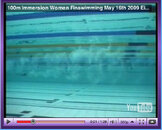I'm not sure who is asking from Bob Evan's computer, but I don't believe this totally. It's not that we cannot generate the power on an upstroke, it's that the orientation of the fin is not as good for generating backwards thrust on the upstroke. But in order to use the flutter kick in any kind of balance, you need to have some thrust on the upstroke too. If you look at the Navy diver using Duck Feet fins many, many years ago, you'll see that the upstroke fin is providing some propulsion, but not as great because of the angle. It also provides balance to the stroke.
When I was training as an instructor for NAUI, we had to do a rescue through about 200 yards of surf, doing in-water mouth-to-mouth all the way in (and yes, in those days it was really done by the instructor trainees to another trainee). During the first part of that exercise, I lost one fin (my first Jet Fins). Kicking with only one fin is no fun, and shows that the balance of the upstroke is pretty vital to the propulsive effort.
Now, I have used Force Fins, and tested them years ago (although not all models). I found that they are very effective on the downstroke, but almost totally ineffective (by design) on the upstroke. My first try with them was memorable, as my feet came completely out of the water on the upstroke. I was used to having that resistance, and that propulsion, from the upstroke. I learned with some time with the fins that if they were to be maximally effective, the downstroke had to be very hard (getting the maximum flexion of the blade) and the upstroke very easy (as there was no effort to the upstroke). It is a very different style of swimming, but once adapted to it, the fins do very well. But I have not made any comparisons with other brands that I have times for.
If you look at the diagram below, you will see that there is a component backward for the upstroke, even with the flat blade fin. Yes, there is force generated on both strokes, as I tried to explain above. If you will look at the wake turbulence of the 100m finswim that was posted on the Texas Finswimming website (see the photo below) you can see that there is force from the monofin both in the down and upward stroke. This shows by the symmetry of the bubble path that the finswimmers generate. By the way, what do you think of swimming 100 meters in 41.51 seconds?
The split fin does orient the fin to provide more backwards-looking thrust, just as the scoop fin does. It probably works best with a fast kick, rather than a slow one, as the water is pushed against harder with the faster kick. By this I mean that because the water is a fluid it would more easily escape through the split if pushed slowly, verses a rapid thrust.
SeaRat






